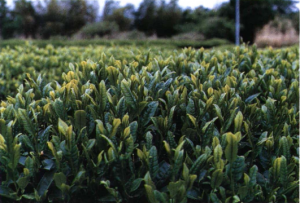
Fukumidori (ふくみどり) is a good cultivar for northern regions in Japan, because it offers exceptional resistance to cold weather.
It’s a normal budding cultivar, which can be harvested one day later than Yabukita.
Right now it is mainly found in the prefectures of Saitama and Ibaraki for the production of sencha.
I haven’t tried a tea made with this cultivar, but inside Japan it seems that it’s not hard to obtain if you order it online.
History of Fukumidori
In 1948, a cross of Yabukita and Sayamamidori resulted in a cultivar known as 23F1-107.
Although this new cultivar had some merits, its buds were too big and hard to process. Because of this, it was abandoned for many years.
Much later, in 1957, the researchers at the Saitama Prefecture Tea Experimental Station decided to continue their previous work.
The idea was to modify the cultivar slightly, so they crossed 23F1-107 back with Yabukita. This was how Fukumidori was born.
It was registered in 1986 as tea cultivar number 36 with high expectations.
Fuku (福) means good fortune, so the idea behind the name is for Fukumidori to bring success to the tea farmers.
Characteristics of Fukumidori
Fukumidori is more resistant to cold weather than Yabukita, and produces 30% more yield at harvest.
However, it is susceptible to anthracnose. Special care must be taken in regards to this disease.
Once processed, the leaves have a refreshing aroma that’s different from Yabukita. It makes a high quality tea, with good taste and color.




